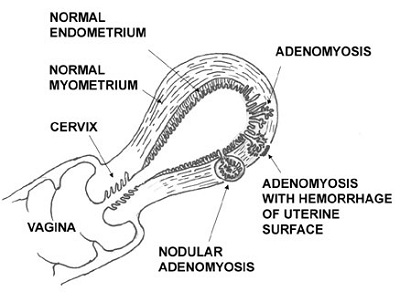The condition in which the inner lining of the uterus (the endometrium) breaks through the muscle wall of the uterus (the myometrium) is called adenomyosis. The displaced endometrial tissue continues thickening, breaking down and bleeding — during each menstrual cycle. Therefore, menstrual cramps is caused, lower abdominal pressure, and bloating before menstrual periods. Adenomyosis is confined to the uterine muscle as a benign disease. Women in their early to middle 40s can get the disease frequently. Patient with this condition also have endometriosis, the rate is 12%, this conclusion was got from various studies.

Adenomyosis Causes
Although people don't know the causes of adenomyosis, experts propose some possible causes of this condition:
Excess levels of the hormone estrogen
We do know that women diagnosed with adenomyosis commonly have excess levels of the hormone estrogen…the disease is encouraged to spread monthly.
Growth of invasive tissue
Some experts believe that adenomyosis results from the direct invasion of endometrial cells from the lining of the uterus into the muscle that forms the uterine walls.
As an outcome of tubal ligations, adenomyosis has been noticed an increase in the disease, and it in women who have reported both c-sections and pregnancy terminations) has also been observed. At this point, however, the reason for the disease continues to be inconclusive.
Origins of development
A known genetic, as with endometriosis link is also present, and it does tend to run in family history. A break in the normal boundary of cells that line the uterus may be caused by an inflammation of the uterine lining during the postpartum period. Surgical procedures on the uterus may have a similar effect.
Adenomyosis Symptoms
Most of the time, adenomyosis may cause symptoms to women like some tips listed below, and sometimes adenomyosis is silent.
Menstrual bleeding which is heavy or prolonged .
During menstruation, women may feel severe cramping or sharp, knifelike pelvic pain(dysmenorrhea).
Throughout your period and worsen as you get older, you can feel menstrual cramps.
Having sex and feeling pain.
During your period, there are blood clots that pass.
Your uterus may get bigger. You may notice that your lower abdomen seems bigger or feels tender although you might not know if your uterus is enlarged.
Adenomyosis Dianogsis
Adenomyosis is made a difficult disease to conclusively diagnose since other uterine diseases can cause signs and symptoms similar to it. And here are some diagnostic methods for women:
MRI or transvaginal ultrasound
Magnetic resonance imaging (MRI) is a test that a magnetic field and pulses of radio wave energy were used to make pictures of organs and structures inside the body. MRI gives different information about structures in the body in many cases. And the working function of transvaginal ultrasound is as same as MRI. When confirming a diagnosis of adenomyosis in women with abnormal uterine bleeding, the two can be used.
Biopsy of uterine muscle
When obtaining, these can be problematic. Via laparoscopy or hysteroscopy and a tissue sample retrieved, a long needle can be placed into the uterus. Areas of biopsy are unseen and the pathology in question may be missed because this technique is a “blind approach” into the uterus, hence rendering an incorrect or false negative result.
Exam of pelvic
An enlarged and tender uterus may be revealed by a pelvic exam. A doctor can see the uterus, its lining, and its muscular wall by an ultrasound. Ultrasound can help to rule out other conditions with similar symptoms even though it cannot definitively diagnose adenomyosis.
Adenomyosis Treatment
Multitude of pain relievers and narcotics
Many of the patients have been on a multitude of pain relievers and narcotics. They can and do give the woman some relief and some type of quality of life even though they do nothing to directly treat the spreading of adenomyosis. In advance stages of the disease, most women have great difficulty performing even basic functions during the day, and these drugs can help give them some control over their life.
Anti-inflammatory drugs
Your doctor may have you try anti-inflammatory medications if you're nearing menopause, such as ibuprofen (Advil, Motrin IB, others), to control the pain. By starting an anti-inflammatory medicine two to three days before your period begins and continuing to take it during your period, you can reduce menstrual blood flow and help relieve pain.
Hormone medications
Heavy bleeding and pain associated with adenomyosis may be lessened by combined estrogen-progestin birth control pills or hormone-containing patches or vaginal rings. It may help regulate heavy bleeding and clotting in some patients in the short term, but the disease is still spreading into the uterus. Eventually the pills will become ineffective for symptom control, and at that point the adenomyosis is well advanced.
Hysterectomy
What is easier, less stressful and safer for the patient? The answer is hysterectomy. For women whose pain is severe and menopause is years away, this treatment is more suitable. If you are young and have the requirement of giving birth, removing your ovaries isn't necessary to control adenomyosis.
Herbal medicine
Hysterectomy can be a good treatment for women whose menopause is years away, taking herbal medicine can be a cure for women who still have the requirement and the pain is severe. Herbal medicine is a conservative treatment for it allows women to maintain the ability of giving birth. Fuyan Pill is the best herbal medicine of adenomyosis.

